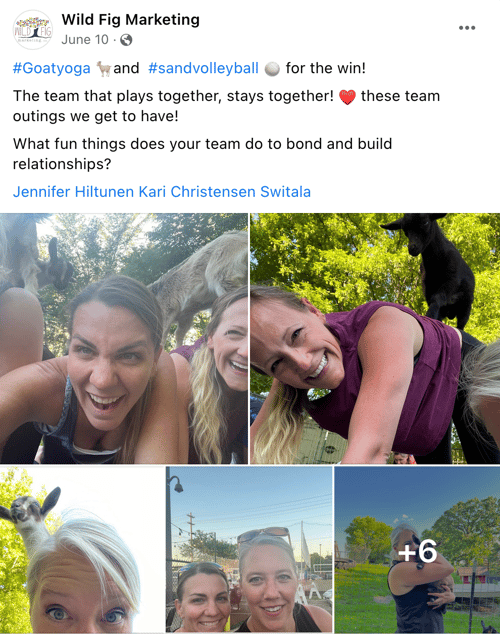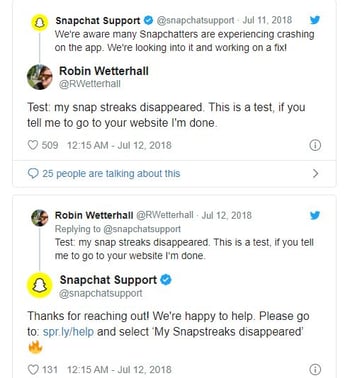10 Marketing Trends You’ll See in 2023
In this rapidly changing world, will you be able to pivot your strategy to swoop up new opportunities?
7 min read
Kari Switala
:
October 19, 2022

Is your marketing bland?

Boring?

Ineffective?

Does it sound just like everyone else’s?

If so, it’s time for a new approach. And believe it or not, you already have what you need to put a spark back into your marketing: YOU!
You—and your team—are unique. You offer something the competition can’t: your personality, your perspective, and your values. In other words, your company culture.
The truth is, your customers want to know who you are, not just what you sell. There’s a place in the market for your unique voice and personality…and your ideal customers and prospects want to see it.
That’s why infusing company culture into your marketing is so effective. Marketing with personality is much more engaging. It draws your audience in, making them feel more connected to you.
But how do you leverage your culture in your marketing? Funny you should ask…we have a few thoughts on the topic.
Your culture affects every part of your business, so it should be included in every part of your business. Applying your company culture to all aspects of your business (including your marketing) helps make sure your strategy is aligned with your big picture goals.
But that’s not the only reason why infusing company culture into your marketing is important.
 People want to connect with other people, not corporations. And they decide who they’ll work with based more on emotion than logic. People generally choose to buy from or do business with those they know, like, and trust.
People want to connect with other people, not corporations. And they decide who they’ll work with based more on emotion than logic. People generally choose to buy from or do business with those they know, like, and trust.
It’s basic likability factor.
You need to connect with your audience on a more human level through shared interests and values. Use your marketing to show who you are (your people, your personality) and why you do what you do (your passion, what drives you).
Example time:
 At Wild Fig, one of our values is fun. You can see that value play out in everything we do—from our website and social media to our email newsletters to our team meetings and the local events we take part in.
At Wild Fig, one of our values is fun. You can see that value play out in everything we do—from our website and social media to our email newsletters to our team meetings and the local events we take part in.
Since we put out the “fun vibe” everywhere we go, we tend to attract clients who value that too. Which, in turn, makes our job way more fun…see how that works? It’s circular—we show who we are, we attract clients who value that, we cultivate relationships on that foundation, and that value gets stronger in our business.
 Sharing your personality and values will help you reach your target audience better…and draw in more of the prospects you really want.
Sharing your personality and values will help you reach your target audience better…and draw in more of the prospects you really want.
Like attracts like. Think about the kind of clients you want to do business with: Who is your ideal customer? It’s pretty likely that your answer will be a reflection of your own company values. Which means that if you showcase your company culture in your marketing, you’ll be more likely to attract clients who share those values.
Plus, you’ll find it’s easier to attract top talent when you’re hiring.
People want to be part of companies who share their values and offer great work environments. If your marketing is nothing more than an endless string of sales pitches, it’s really hard to see who you are as a business or what it’s like to work there.
Your culture drives your work environment. It shapes the way you do business every day. It should also shape your marketing strategy.
Younger generations of consumers are especially interested in working with companies who share their values.
 Millennials are the biggest generation yet, and are heading into their prime spending years. And Gen Z (the second largest generation) is right behind them. Both Millennials and Gen Z are laser focused on buying from companies who are passionate about the same causes they are.
Millennials are the biggest generation yet, and are heading into their prime spending years. And Gen Z (the second largest generation) is right behind them. Both Millennials and Gen Z are laser focused on buying from companies who are passionate about the same causes they are.
Check out these stats:
In a digital world, showcasing your brand, who you are, and what you believe in is SO important because it sets you apart from the sea of competitors you’re up against.
Infusing your marketing with your personality helps you stand out from every other business. It shows your audience what you stand for, how you’re different, and why they should pick you over the competition.
And when your audience resonates with your message, you’ll form stronger connections with them.
Your culture should be front and center in your marketing. It should be clearly visible and easily understood in all the ways you show up, both online and off. That includes your website, social media, community engagement, networking events, hiring process…everywhere.
Open, honest communication is what people really want from the companies they do business with. Don’t be afraid to get a little personal.
We’re not saying you should share the most intimate details of your life…just talk about your dog, the book you’re reading, or the new restaurant you checked out this weekend.
In your blogs, social media, and email content, share stories from your life or the day-to-day of your business. Offer behind-the-scenes peeks (customers love a good behind-the-scenes peek!) into your processes, people, and what it’s like to run your business.
Use a conversational tone in your communication—it makes you more approachable and relatable. Jargon and overly academic language can make you seem stiff and distant, putting a wall between you and your audience. Break down that wall by talking to your audience like you’re chatting at a cocktail party, rather than giving a presentation.
This doesn’t mean you can’t evoke a no-nonsense professionalism if that’s who you are…just make sure your communication doesn’t sound like a string of million-dollar thesaurus words.
Anonymity online can make your company feel distant to potential customers. If you’re posting regularly but you never share photos of yourself or your team, you’ll come off as cold and unapproachable…even robotic.
You’ll attract more customers if people feel like they’re interacting with a real person they can relate to and connect with. And they’ll automatically feel more of a connection with you if they can see your face.
Include photos of you and your team on your website and social media. And don’t just use headshots! Headshots are a fine place to start (especially for your website and LinkedIn profiles), but to really connect with people you need more.
Post photos of:

…and so on. Build a stronger connection by giving your audience a chance to get to know you and your company better. That stronger connection will lead to more customer loyalty.
Statistics are great, and they have their place. But people don’t relate to statistics—they relate to stories.
 Storytelling creates an emotional connection with your audience. Emotionally connected customers will visit your business more, buy more often, bring you more referrals, and even be less concerned about price.
Storytelling creates an emotional connection with your audience. Emotionally connected customers will visit your business more, buy more often, bring you more referrals, and even be less concerned about price.
Tell stories:

Take your stories offline as well. Keep a few stories in your back pocket to share at networking events and in prospect meetings to keep things more engaging.
A few tips for telling compelling stories:
 Respond to every social media comment, email, and online review with authentic messages. Never use canned responses. 🤦♀️ 👉
Respond to every social media comment, email, and online review with authentic messages. Never use canned responses. 🤦♀️ 👉
This doesn’t mean you can’t use automation. It just means you need to make sure your automated messages are written in a conversational tone (in other words, make sure they don’t sound robotic).
Don’t ignore negative comments. Negative comments or reviews are just as much an opportunity to connect with your audience as positive ones are! Even if your response doesn’t convince the commenter to give your business another try, potential clients will see it…and they’ll learn a lot about who you are as a company.
Offering authentic responses like this shows you’re available to your customers, you care about what they have to say, and you’re responsive to feedback.
Events are a fantastic way to showcase your culture. Invite your customers, prospects, email lists, and social media followers to fun events hosted by your company. Think about your core values and plan events that reflect those values.
For example:
Do you value education? Host free webinars on a variety of topics you have expertise in. Offering a bit of your knowledge for free is a great way to make connections.
 Do you value taking care of the environment? Host an event where people can bring in their old cell phones or other electronics for recycling. (Check out our client Repowered if you’re in the Twin Cities area!)
Do you value taking care of the environment? Host an event where people can bring in their old cell phones or other electronics for recycling. (Check out our client Repowered if you’re in the Twin Cities area!)
Do you value connection and fun? Host regular client appreciation parties or community gatherings with great food, games, and lots of laughter.
 We hope these ideas and tips help you inject more of your company’s personality and values into your marketing. But if you’re feeling stuck or overwhelmed, we’ve got you!
We hope these ideas and tips help you inject more of your company’s personality and values into your marketing. But if you’re feeling stuck or overwhelmed, we’ve got you!
Contact us for a FREE Digital Marketing Analysis. We’ll help you determine how to use your marketing efforts to share more of your company culture and personality so you can connect more effectively with your audience.

In this rapidly changing world, will you be able to pivot your strategy to swoop up new opportunities?
![Why It’s Crucial To Humanize Your Brand in the Age of AI [+ 12 Ways To Do It]](https://www.wildfigmarketing.com/hubfs/bigstock-Two-cheerful-small-business-ow-277396642.jpg)
With increased adoption of smart technology, AI, and automation, brands have the opportunity to accomplish more faster—potentially outperforming even...

Part 3 of our Key Metrics Series Email marketing, when done well, can be one of the most effective ways to engage your audience. However, it doesn’t...